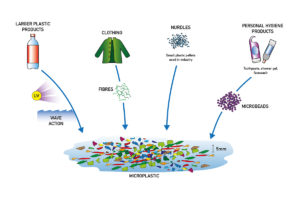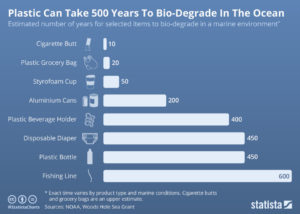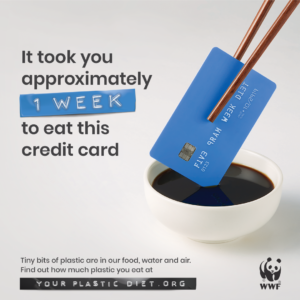Published 1 March 2020 ● Last Updated on 15 July 2020
Microplastics are everywhere – from remote areas in the Pyrenees Mountains in France that are covered with airborne microplastics to right at the bottom of the Mariana Trench, the world’s deepest ocean trench, where a plastic bag and candy wrappers were discovered and even in the Arctic snow, where researchers have found high levels of microplastic trapped in the ice cores. And it isn’t only nature that is filled with it; we’ve known for a while that animals, birds, insects and especially marine life have been adversely affected by consumption of microplastics. What we don’t know yet is how harmful are microplastics to humans? And this question needs some answers fast because the air we breathe, the water we drink, the food we eat, all of it contains microplastic and now, even human poop has it!
Microplastics 101
What are microplastics?
Microplastics are inanimate, tiny, colorful, plastic pieces that measure between 1 micrometer to 5 millimetres in size. Due to their small size, it is difficult to filter them out from our waste and they are spreading across the globe – floating in water, flying in air and creating layers on land! They get there either from primary or secondary sources.

We produce nearly 300 million tonnes of plastic waste every year, a number that is almost equal to the weight of the entire human population. Over time, with exposure to the elements the plastic waste disintegrates into smaller bits or microplastics – a process that can take between 10 years to 1000 years! Microplastics formed in this way are considered to be from a secondary source.
Some of the common primary sources of microplastics are,
- Personal Care Products: Many of our personal care products contain microbeads (tiny pieces of polyethylene plastic) that are used to replace natural ingredients as exfoliants. While a few countries have banned the use of products that contain it, there are many where they are still readily available.
- Synthetic Textiles: Globally, nearly 65% of textile produced has synthetic fibres in it, and every time we wash the garment, tiny pieces of microfibres (a type of microplastic with a fibrous texture) directly enter the water source and this is another major cause of microplastic pollution in the oceans.
- Teabags: A recent study has found that plastic tea bags release billions of micro and nano plastic into a cup of boiling water. Have a tea fixation? Just opt for loose tea or paper tea bags next time!
- Plastic Pellets: Most of your plastic goods started off by being a plastic pellet- this is the raw form of the material and is melted to give it the final shape. From toys to milk containers to car upholstery, pellets are used in all. They usually measure 2 to 5 millimetre in size and at various stages of pre production there is accidental loss and these particles end up polluting the environment.
- Tyres: Who would have thought that the natural processes of abrasion of tyres on the road actually contribute to microplastic waste in the oceans. Today, tyres are a mix of natural rubber and synthetic rubber which is nothing but plastic polymer. As wear and tear happens, tiny plastic shreds peel off and add to the microplastic pollution menace.
While these are some of the main known sources of microplastic pollution, there are many others that are being researched like marine coatings or road markings and more that are still unknown to us. In case you were wondering, there are plastic particles around us that are smaller than microplastics– they are called nanoplastic particles and they measure less than 1 micrometer in size – that is 1000 times smaller than an algae cell!
Why are microplastics a matter of growing concern?
#Threat 1: Microplastics degrade the environment as it takes years to decompose and releases chemicals in the process
For starters, like any other plastic material these tiny pieces take forever to decompose in the environment. And unlike bigger plastic trash that can be removed from water sources and garbage, these tiny pieces of plastic are next to impossible to filter out thereby polluting almost everything.
Also, plastic is not a natural material and therefore, the chemical elements that it contains are most definitely toxic to any living organisms – a poison that is slowly released within the body once microplastics are ingested by animals, marine life or humans!

#Threat 2: Microplastics harm marine biodiversity
What do microplastic, plankton and hungry fish have in common? They like to ‘hang out’ on the surface of the oceans where currents converge and eventually form the circle of life in the oceans! A 2017 study highlighted that anchovies often mistake microplastic for food due to the smell of algae coating it, and that’s how plastic enters the gut of the bigger fish or humans eating the anchovy (Love anchovy on your pizza? Think again!). Sadly plastic not confined to the surface of the water bodies – synthetic fibres have also been found in creatures living in the deepest trenches of the world.
#Threat 3: Humans are beginning to consume microplastic, not enough research on effects yet
Now that humans are also consuming microplastics that are present in their food, water and air, it is worrisome as there is very little research to show the effects that microplastics will have when ingested, but one can be pretty sure that it is not going to be beneficial to our health in any way! Wondering which part of your diet contains microplastic? Read on to find out…
Consuming Microplastics: Food items, bottled water and air
Last year, WWF made a startling declaration: humans were ingesting nearly 2000 microplastic pieces weighing about 5 grams EVERY WEEK – that is the weight of a credit card! The study carried out by the University of Newcastle, Australia estimates that 100,000 tiny pieces or 250 grams of plastic are ingested yearly by an average human being. Want to get an estimate of your consumption of microplastics? Find out how much at yourplasticdiet.org

Here is a list of items that are a part of our daily lifestyle but have tested positive for microplastics.
Air | Every breath you take…you’re probably inhaling 11 tiny bits of plastic per hour! And if you thought that the air within your homes is less polluted than outdoors, think again. A research article found that indoor air has a much larger concentration of synthetic fibres than outdoor air, released from our clothes and upholstery and we when we breathe in this air, we inhale microplastics particles, many of which remain inside our lungs causing respiratory and cardiovascular diseases. Crawling babies and children are at a much higher risk than adults as their respiratory systems are still developing.
Water│In a study conducted by Orb Media in 2017, they found that nearly 83% of drinking water samples globally contained synthetic fibres. Another study that was published in Frontiers in Chemistry in 2018 pointed out that out of the 259 bottle water samples that were tested, nearly 93% showed microplastic contamination. These studies were two out of the many that were conducted and the alarming results prompted WHO to publish a report on precautionary measures that need to be taken.
Salt| Can you imagine food without salt? If you can’t then be aware that nearly 90% salt brands worldwide tested positive for microplastics present in them. And no matter where the salt was sourced from – sea, lake or rock – all contained a certain percentage of microplastics; sea salt being the highest.
Fish | For those who enjoy their seafood and fish, read the fine print on your menu card – served with microplastics! All the plastic that ends up in our seas, eventually is ingested by marine animals and some of them are humans favourite food – it’s a complete cycle – what you throw, that you will eat! In a 2017 study, it was found that out of 25 most important fish species that contribute to the global marine fisheries, nearly 12 contained microplastics. Samples of oysters, shellfish and mussels from different parts of the world have also been found to contain microplastics.
Apart from the above, signs of microplastic particles have also been found in beer, tea bags and even honey (no conclusive research yet!). If you want to know how much of microplastics you could be ingesting, you can calculate it here.
Is there any solution to the microplastic problem?
Since the 1950s, scientists estimate that 8.3 billion metric tonnes of plastic has been produced and only 9% recycled – honestly, there is no easy solution in sight! Even if every single person stopped using plastic right this second, we still have a huge amount in our garbage dumps, oceans, mountains, basically EVERYWHERE – that will take hundreds of years to decompose. And as time goes by macro pieces will turn to micro, then nano and become a part of everything including our very bodies – and as of now, we don’t have any conclusive information on how microplastics will affect humans.
The best thing one can do now is be aware of the problem at hand and try and minimize non-essential plastic usage as much as possible.
Related Articles:



0 Comments